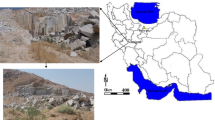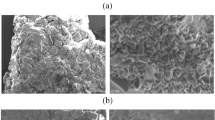Abstract
Coal mining operations below the water table of surface and underground mines are common. Therefore, a better understanding of rock behaviour in dry and water-saturated conditions is critical in rock engineering projects. In this paper, Lower Gondwana coal measure rock (sandstone and shale) samples have been collected from 10 different mines (eight collieries) in Jharia and Raniganj coalfield of Damodar basin, India. The strength parameters (uniaxial compressive strength (UCS) and Brazilian tensile strength (BTS)) primarily govern the design aspects in mining. These are the most common input parameters for any rock mass classification. Hence, changes in the strength parameters of coal measure rocks under dry and water-saturated conditions would adversely lead to the change in the rock mass classification of the rock. Moreover, the direct determination of strength parameters is expensive, time-consuming, field-inaccessible, laborious, destructive, and requires experienced labour, while an indirect method to estimate the strength parameters from ultrasonic pulse velocity (UPV) is cheap, easy, quick, field-accessible, non-destructive, and straightforward. The UPV, UCS, and BTS in dry conditions, density (ρ), porosity (φ) and rock type information were used as input parameters for predicting the UPV, UCS and BTS in saturated conditions using simple regression (SR), multivariate regression (MR) and artificial neural network (ANN). The change in UPV, UCS and BTS from dry to saturated conditions were observed to be a function of the intrinsic properties (ρ and φ) of coal measure rocks. Finally, a comparative analysis between SR, ANN and MR was performed in a measured vs. predicted 1:1 scatter plot.











Similar content being viewed by others
References
Abdi Y, Khanlari G R and Jamshidi A 2018 Correlation between mechanical properties of sandstones and P-wave velocity in different degrees of saturation; Geotech. Geol. Eng. 10 1–10.
Altindag R 2012 Correlation between P-wave velocity and some mechanical properties for sedimentary rocks; J. South. Afr. Inst. Min. Metall. 112 229–237.
Azimian A 2017 Application of statistical methods for predicting uniaxial compressive strength of limestone rocks; Acta Geotech. 12 321–333.
Chary K B, Sarma L P and Lakshmi K J P 2006 Evaluation of engineering properties of rock using ultrasonic pulse velocity and uniaxial compressive strength; Proc. Natl. Semin. 379–385.
Dyke C G and Dobereiner L 1991 Evaluating the strength and deformability of sandstones; Quart. Eng. Geol. 24 123–134.
Fox C S 1930 The Jharia coalfield; Geol. Surv. India Memoir 56 255.
Geological Survey of India (GSI) 2003 Coal resources of West Bengal (ed.) Dutta A B, Bull. Geol. Surv. Ind. Ser. A 45 1–109.
Ghabousi J, Garret Jr J H and Wu X 1991 Knowledge-based modelling of material behaviour with neural networks; J. Eng. Mech. ASCE 117(1) 132–153.
Hawkins A B and McConnell B J 1992 Sensitivity of sandstone strength and deformability to changes in moisture content; Quart. Eng. Geol. 25 115–130.
International Society of Rock Mechanics (ISRM) 1981a Suggested method for rock characterisation, testing and monitoring; In: ISRM Commission on Testing Methods (ed.) Brown E T, Pergamon Press, Oxford, pp. 107–110.
International Society of Rock Mechanics (ISRM) 1981b Suggested method for rock characterisation, testing and monitoring; In: ISRM Commission on Testing Methods (ed.) Brown E T, Pergamon Press, Oxford, pp. 113–114.
International Society of Rock Mechanics (ISRM) 1981c Suggested method for rock characterisation, testing and monitoring; In: ISRM Commission on Testing Methods (ed.) Brown E T, Pergamon Press, Oxford, pp. 119–121.
International Society of Rock Mechanics (ISRM) 1981d Suggested method for rock characterisation, testing and monitoring; In: ISRM Commission on Testing Methods (ed.) Brown E T, Pergamon Press, Oxford, pp. 84–85.
Kahraman S 2007 The correlations between the saturated and dry P-wave velocity of rocks; Ultrasonics 46 341–348.
Kahraman S and Yeken T 2008 Determination of physical properties of carbonate rocks from P-wave velocity; Bull. Eng. Geol. Environ. 67 277–281.
Karakul H and Ulusay R 2013 Empirical correlations for predicting strength properties of rocks from P-wave velocity under different degrees of saturation; Rock Mech. Rock Eng. 46 981–999.
Khandelwal M and Singh T N 2009 Correlating static properties of coal measures rocks with P-wave velocity; Int. J. Coal Geol. 79 55–60.
Kilic A and Teymen A 2008 Determination of mechanical properties of rocks using simple methods; Bull. Eng. Geol. Environ. 67 237–244.
Lin M L, Jeng F S, Tsai L S and Huang T H 2005 Wetting weakening of tertiary sandstones – microscopic mechanism; Environ. Geol. 48 265–275.
Mashinskii E I 2009 Strain amplitude-dependent attenuation of P and S waves in dry and water-saturated sandstone under confining pressure; Russian Geol. Geophys. 50 734–738.
Rahman T and Sarkar K 2021 Lithological control on the estimation of uniaxial compressive strength by the P-wave velocity using supervised and unsupervised learning; Rock Mech. Rock Eng. 54 3175–3191.
Rahman T, Sarkar K and Singh A K 2020 Correlation of geomechanical and dynamic elastic properties with the P-wave velocity of Lower Gondwana coal measure rocks of India; Int. J. Geomech. 20(10) 04020189.
Sharma P K and Singh T N 2008 A correlation between P-wave velocity, impact strength index, slake durability index and uniaxial compressive strength; Bull. Eng. Geol. Environ. 67 17–22.
Singh V K, Singh D and Singh T N 2001 Prediction of strength properties of some schistose rocks from petrographic properties using artificial neural networks; Int. J. Rock Mech. Min. Sci. 38 269–284.
Sharma L K, Vishal V and Singh T N 2017 Developing novel models using neural networks and fuzzy systems for the prediction of strength of rocks from key geomechanical properties; Measurement 102 158–169.
Steiger R P and Leung P K 1990 Lecture: Predictions of wellbore stability in shale formations at great depth; In: Eurock (Rock at great depth) (eds) Maurý et Fourmaintraux, Balkema, pp. 1209–1218.
Torok A and Vasarhelyi B 2010 The influence of fabric and water content on selected rock mechanical parameters of travertine, examples from Hungary; Eng. Geol. 115 237–245.
Vaidyanadhan R and Ramakrishnan M 2010 Geology of India; Geol. Soc. India 2 615–661.
Vasarhelyi B 2003 Some observations regarding the strength and deformability of sandstones in case of dry and saturated conditions; Bull. Eng. Geol. Environ. 84 70–74.
Vasconcelos G, Lourenco P B, Alves C S A and Pamplona J 2007 Prediction of the mechanical properties of granites by ultrasonic pulse velocity and Schmidt hammer hardness; North American Masonry Conference, Missouri, 3–5 June. The Masonry Society, CO, pp. 980–991.
Yasar E and Erdogan Y 2004 Correlating sound velocity with the density, compressive strength and Young’s modulus of carbonate rocks; Int. J. Rock Mech. Min. Sci. 41 871–875.
Youash Y Y 1970 Dynamic physical properties of rocks: Part II, experimental results; Int. Soc. Rock Mech. Proc.: 2nd Congr. Int. Soc. Rock Mech., Beograd 1 185–195.
Acknowledgements
The authors acknowledge the resources provided by the Indian Institute of Technology (Indian School of Mines) Dhanbad. They are also thankful to the Eastern Coalfields Ltd. and Bharat Coking Coal Ltd. authorities for their support and guidance during the sample collection process.
Author information
Authors and Affiliations
Contributions
Tabish Rahman: Conceptualisation, methodology, writing – original draft preparation, formal analysis, and visualisation. Kripamoy Sarkar: Writing – reviewing and validation.
Corresponding author
Additional information
Communicated by Saibal Gupta
Rights and permissions
About this article
Cite this article
Rahman, T., Sarkar, K. Estimating strength parameters of Lower Gondwana coal measure rocks under dry and saturated conditions. J Earth Syst Sci 131, 175 (2022). https://doi.org/10.1007/s12040-022-01920-2
Received:
Revised:
Accepted:
Published:
DOI: https://doi.org/10.1007/s12040-022-01920-2




